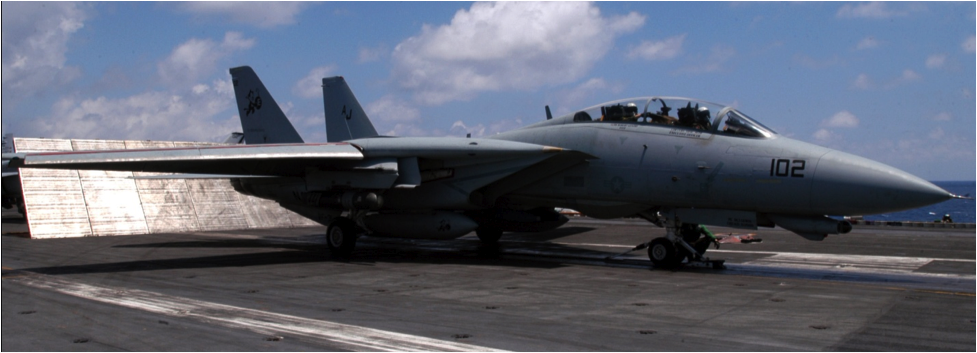Posted on April 11, 2011
The F-14
From the 1970s through 2006, the Grumman F-14 Tomcat was the defender of the fleet. These huge, fast, swept-wing fighters could take on anything in close-in dog fights and could shoot down enemy aircraft 50 miles away. Toward the end of the Tomcat’s life, F-14s became Bombcats, capable of delivering precision bombs against distant land targets. F-14s starred the movie Top Gun, which also featured co-star Tom Cruise.

Preparing an F-14 Tomcat for launch. (U.S Navy photograph 050222-N-4308O-075, Feb. 22, 2005, by Photographer’s Mate Airman Ryan O’Connor)
Our Tomcat (S/N 163904) “Felix 102”
By the beginning of 2006, there were only two F-14 squadrons left in the Navy. Both were flying combat missions in the Middle East. VF-213 was the “Black Lions.” VF-31 was the “Tomcatters.” The tail insignia of VF-31, created in 1948, was a black Felix the Cat carrying a lit bomb.[1]

Insignia of the VF-31 Tomcatters. (U.S. Navy photograph, http://www.history.navy.mil/insignia/vf/vf31.jpg)
Not surprisingly, the squadron’s call sign was “Felix.” Our F-14D, Serial Number 163904, was Felix 102.

Felix 102 Getting Ready for a Cat Launch (U.S. Navy photo)
In March, the two squadrons returned to their home base, Naval Air Station Oceana in Virginia. VF-213 quickly stood down and began to reequip with FA-18 Hornets. VF-31 remained on duty in case a sudden crisis required it to move out again. Finally, VF-31 was removed from standby duty and prepared to end its Tomcat days. The Navy decided to end the era with a large celebration at Oceana. “Tomcat Sunset” lasted for three days. It drew thousands of F-14 pilots, air crews, and enthusiasts.

Tomcat Sunset (U.S. Navy photo 060922-N-0841E-148)
A few VF-31 aircraft, including 102, had their Felix tail insignia and replaced with special artwork for the occasion.

Tomcat Sunset Tail Marking on Felix 102 (Photo by [email protected] at Pearl Harbor Aviation Museum)
The celebration ended on September 22, with a symbolic last flight. The honor was scheduled to be given to Felix 102. Its pilot would be the squadron’s CO, Commander Jim Howe, and its RIO would be Lieutenant Commander Bill Lind. Unfortunately, Felix 102 took the occasion to remind everybody what a maintenance nightmare the F-14 had become in its final years. A generator failed, and the last flight was flown by the backup plane, Felix 107.

Felix 102 at Tomcat Sunset (U.S. Navy Photograph 060922-N-5555T-001)
In any case, this final flight really was symbolic. The next month, the eleven aircraft of the squadron flew from Oceana to their final destinations. Felix 102 flew to NAS North Island. The final Tomcat landed at Republic Airport, near its Grumman birthplace. And, of course, there are still those Iranian F-14As.
In 2008, Felix 102 moved to its final destination, Pacific Aviation Museum in Pearl Harbor, Hawaii. She travelled on the assault ship USS Bonhomme Richard. As the ship approached Pearl Harbor, the 102 was placed in front, looking like a hood ornament among the ship’s helicopters. She was winched off the ship, moved by barge to Ford Island, and winched onto land. She was pulled to her new home, Hangar 79.

Felix 102 Thanking the USS Bonhomme Richard (U.S. Navy photograph 080701-N-1722M-033)

Felix 102 in her new home, Hanger 79 at Pearl Harbor Aviation Museum.


